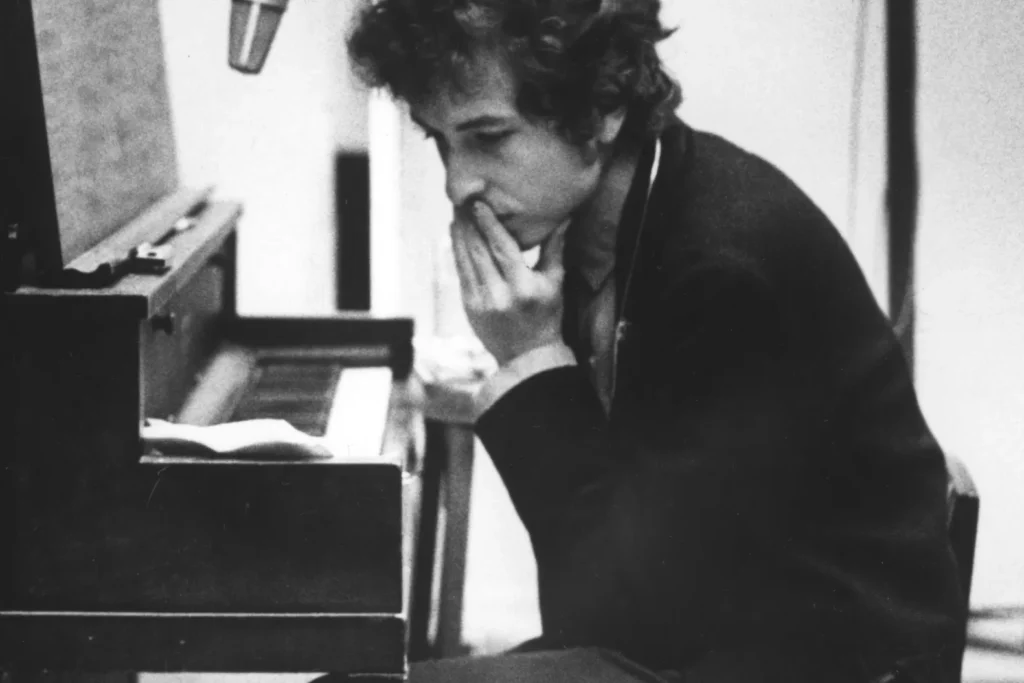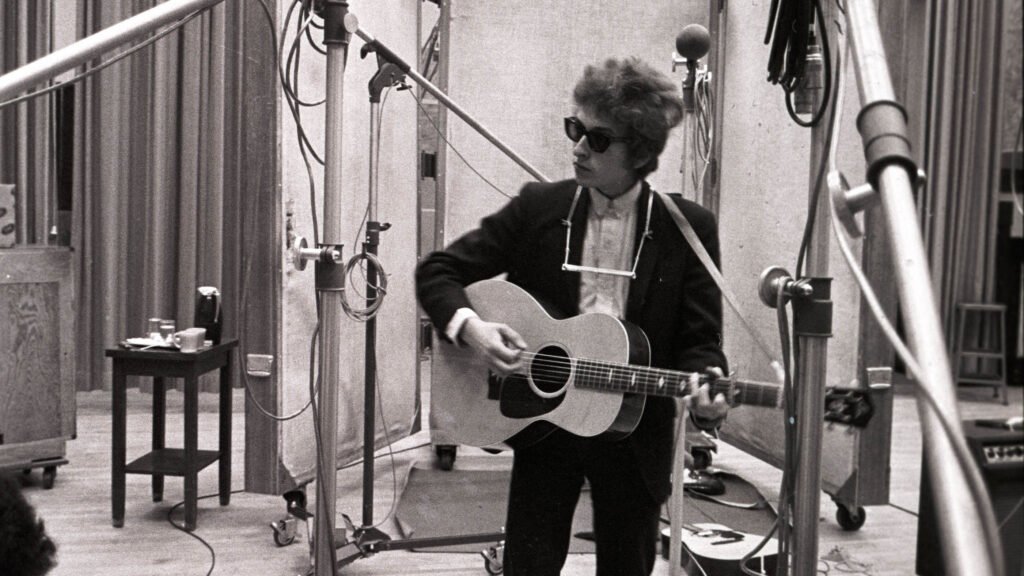“Like a Rolling Stone” stands as one of the most transformative songs in music history, a masterpiece that redefined the boundaries of popular music. Released by Bob Dylan in 1965, this six-minute epic broke the conventional three-minute limit for radio singles and challenged the norms of songwriting with its cutting lyrics and innovative sound. More than just a commercial success, “Like a Rolling Stone” became an anthem of social change and a symbol of the burgeoning counterculture movement.
Its profound impact on music is reflected in its enduring popularity and the way it inspired a generation of musicians to explore new lyrical and musical horizons. By blending rock and folk in an unprecedented manner, Dylan not only cemented his place as a musical innovator but also paved the way for future artists to experiment and push the creative envelope.
Context and Background

In the mid-1960s, the music industry was in a state of vibrant transition. The early part of the decade had been dominated by the polished sounds of pop and the burgeoning British Invasion, led by bands like The Beatles and The Rolling Stones. Folk music, with its emphasis on acoustic instrumentation and socially conscious lyrics, was also experiencing a renaissance, influencing the cultural zeitgeist with its calls for civil rights and social change.
Bob Dylan emerged from the folk scene as a prophetic voice, gaining notoriety with his politically charged anthems like “Blowin’ in the Wind” and “The Times They Are A-Changin’.” By 1965, Dylan had already established himself as a key figure in the folk music revival, admired for his poetic lyricism and distinctive vocal style. However, Dylan was restless and began to feel constrained by the traditional boundaries of folk music.
At this juncture, Dylan started to experiment with electric instruments, a move that initially met with controversy, especially among purist folk fans. His decision to go electric culminated in the release of “Bringing It All Back Home” in early 1965, an album that mixed acoustic and electric tracks and hinted at the musical revolution he was about to unleash. This period was marked by a cultural shift towards more experimental and expressive forms of art, a backdrop that set the stage for Dylan’s groundbreaking work.
Creation and Recording Process

The inspiration for “Like a Rolling Stone” came from a place of personal and artistic frustration. In the spring of 1965, Bob Dylan was grappling with the pressures of fame and the constraints of the folk music scene. He was weary of being labeled the voice of a generation and felt a growing discontent with his artistic direction. During this period, Dylan penned a long piece of prose that captured his feelings of alienation and anger, which would later become the foundation for the song.
Dylan distilled this prose into a set of scathing, reflective lyrics. The songwriting process was intense and cathartic, as he poured his disillusionment and yearning for freedom into the verses. The chorus—”How does it feel, to be on your own, like a complete unknown, like a rolling stone?”—emerged as a powerful refrain that encapsulated the song’s rebellious spirit and existential angst.
The Recording Sessions
The recording sessions for “Like a Rolling Stone” took place in June 1965 at Columbia’s Studio A in New York City. Dylan collaborated with a group of talented musicians, including guitarist Mike Bloomfield, organist Al Kooper, pianist Paul Griffin, bassist Joe Macho Jr., and drummer Bobby Gregg. The initial sessions were marked by a sense of experimentation and spontaneity. Al Kooper, originally invited to watch the sessions, ended up playing the iconic organ riff that became a defining feature of the song. Despite not being a seasoned organist, Kooper’s contribution added a distinctive and unforgettable layer to the track.
The recording process was not without its challenges. Early takes of the song failed to capture the right feel, and it took several attempts to find the perfect arrangement. On June 16, after numerous takes, the band finally hit the mark with a version that balanced raw energy with musical cohesion. This take captured the essence of Dylan’s vision, combining rock intensity with lyrical depth.
Notable moments from the recording sessions include the improvisational spirit that Kooper brought to the organ part and the electric chemistry between the musicians. Dylan’s commanding presence and unwavering vision steered the sessions, pushing the band to deliver a performance that was both groundbreaking and timeless. The final recording, with its driving rhythm, cutting lyrics, and innovative sound, stood out as a monumental achievement in rock music history.
Musical and Lyrical Analysis

“Like a Rolling Stone” is a masterclass in musical innovation and lyrical profundity, marking a significant departure from conventional songwriting of its time. The song’s structure and sound were as revolutionary as its message, establishing new paradigms for both rock and folk music.
Musical Structure and Innovation
The song opens with a distinctive, jangly organ riff played by Al Kooper, setting the tone for what is to come. This riff, combined with Mike Bloomfield’s cutting guitar lines, creates a vibrant, layered sound that was unprecedented in Dylan’s previous work. The rhythm section, featuring Paul Griffin on piano, Joe Macho Jr. on bass, and Bobby Gregg on drums, provides a driving beat that propels the song forward with relentless energy.
“Like a Rolling Stone” eschews the typical verse-chorus structure, opting instead for a series of verses punctuated by a recurring refrain. Each verse builds in intensity, culminating in the powerful, anthemic chorus: “How does it feel, to be on your own, with no direction home, like a complete unknown, like a rolling stone?” The song’s six-minute length was also groundbreaking, challenging the radio-friendly three-minute norm and demanding that listeners engage with it as a complete, immersive experience.
The use of electric instruments and the fusion of rock and folk elements were pivotal in creating a sound that was both raw and polished, familiar yet innovative. This hybridization not only expanded the sonic possibilities for future musicians but also signaled a shift towards more complex and expressive forms of popular music.
Lyrical Themes and Analysis
Lyrically, “Like a Rolling Stone” is a tour de force of imagery and emotion. The song chronicles the fall from grace of a privileged woman who once lived a life of luxury but now finds herself destitute and alone. Dylan’s lyrics are sharp and unsparing, filled with biting social commentary and existential questioning.
The opening lines—”Once upon a time you dressed so fine / Threw the bums a dime in your prime, didn’t you?”—set the stage for a narrative of downfall and disillusionment. Each verse elaborates on this theme, depicting the protagonist’s descent into obscurity and vulnerability. The recurring chorus reinforces the sense of isolation and loss, posing the haunting question: “How does it feel?”
Dylan’s use of vivid, often surreal imagery—such as “Princess on the steeple and all the pretty people” and “Napoleon in rags”—adds depth and complexity to the narrative. These metaphors and allusions create a rich tapestry of meaning, inviting multiple interpretations and resonating on both personal and societal levels.
At its core, “Like a Rolling Stone” is a meditation on identity, change, and the human condition. It captures the zeitgeist of the 1960s, reflecting the era’s tumultuous social changes and the growing sense of disenchantment among the youth. Yet, its themes are timeless, speaking to the universal experience of loss and the search for meaning.
The song’s lyrical innovation lies not only in its content but also in its delivery. Dylan’s vocal performance is raw and impassioned, conveying a sense of urgency and authenticity that amplifies the song’s emotional impact. His phrasing and intonation bring the lyrics to life, making each line resonate with power and poignancy.
Initial Reception

“Like a Rolling Stone” was released on July 20, 1965, and it quickly became a lightning rod for both acclaim and controversy. The song’s length, innovative structure, and electric sound were unlike anything listeners had encountered before, and reactions were immediate and polarized.
Critical Reaction
Upon its release, “Like a Rolling Stone” garnered widespread critical acclaim. Many music critics hailed it as a groundbreaking work that pushed the boundaries of popular music. Critics praised Dylan’s lyrical genius, the song’s bold sound, and its emotional intensity. In a review for The New York Times, Robert Shelton described it as “a revolutionary act” and a “brilliant piece of prose set to music.” Shelton’s assessment reflected the sentiment of many critics who saw the song as a high-water mark in Dylan’s career and in the evolution of rock music.
However, not all reactions were positive. Some traditional folk purists were dismayed by Dylan’s embrace of electric instruments, viewing it as a betrayal of the folk movement. These detractors were vocal in their criticism, particularly in the folk community, where Dylan had been revered as a leading figure. Despite this, the overwhelming majority of critics recognized the song’s artistic merit and its potential to reshape the musical landscape.
Public Reaction
The public reaction to “Like a Rolling Stone” was equally intense. Fans were initially shocked by the song’s departure from Dylan’s earlier acoustic style, but many were captivated by its raw energy and profound lyrics. The song resonated deeply with the burgeoning counterculture movement, which embraced its themes of disenchantment and defiance. It quickly became an anthem for a generation seeking to challenge the status quo and explore new avenues of expression.
The controversy surrounding Dylan’s “going electric” reached a peak at the Newport Folk Festival in July 1965, where he performed an electric set that included “Like a Rolling Stone.” The mixed reaction from the audience—ranging from enthusiastic applause to boos from folk purists—underscored the song’s polarizing effect. This moment, however, solidified Dylan’s resolve to continue his innovative musical journey, and it ultimately contributed to the song’s legendary status.
Chart Performance and Sales Data
Despite—or perhaps because of—its unconventional length and structure, “Like a Rolling Stone” achieved remarkable commercial success. The song quickly climbed the charts, reaching No. 2 on the Billboard Hot 100 in the United States, where it stayed for two weeks. This achievement was particularly significant given the era’s radio format constraints, which typically favored shorter singles.
In the United Kingdom, the song also performed well, peaking at No. 4 on the UK Singles Chart. Its success extended to other international markets, solidifying Dylan’s status as a global music icon.
“Like a Rolling Stone” sold more than a million copies in its first year, a testament to its widespread appeal and enduring impact. Its commercial success not only confirmed Dylan’s versatility as an artist but also demonstrated that audiences were ready for more complex and innovative forms of popular music.
Long-term Impact and Legacy

“Like a Rolling Stone” is not just a song; it is a monumental piece of cultural and musical history that has left an indelible mark on the world. Its long-term impact and legacy can be seen in its profound influence on subsequent music and artists, its transformative effect on Bob Dylan’s career and image, and its significant role in the broader cultural and social landscape.
Influence on Subsequent Music and Artists
“Like a Rolling Stone” broke new ground in the music industry, influencing countless artists across various genres. Its innovative structure, lyrical depth, and electric sound set new standards for what popular music could achieve. The song inspired a generation of musicians to experiment with their songwriting and sound. Artists like Jimi Hendrix, The Beatles, and Bruce Springsteen have all cited Dylan’s work, particularly “Like a Rolling Stone,” as a major influence on their music.
The song’s fusion of rock and folk elements opened the door for more genre-blending in music, leading to the emergence of folk rock as a prominent genre in the late 1960s and beyond. Its success demonstrated that audiences were receptive to longer, more complex songs with substantive lyrics, paving the way for future rock epics like The Rolling Stones’ “Sympathy for the Devil” and Led Zeppelin’s “Stairway to Heaven.”
How It Shaped Dylan’s Career and Image
For Bob Dylan, “Like a Rolling Stone” was a pivotal moment that redefined his career and public persona. Before its release, Dylan was primarily known as a folk artist, a voice of the protest movement with his acoustic guitar and harmonica. The song marked his full-fledged transition into rock music, showcasing his versatility and willingness to defy expectations.
This shift had a profound impact on Dylan’s image. He went from being a folk hero to a symbol of artistic freedom and innovation. The controversy surrounding his “going electric” at the Newport Folk Festival only added to his mystique, cementing his reputation as a trailblazer unafraid to challenge norms. This newfound image allowed Dylan to explore various musical styles throughout his career, from country to gospel to blues, continually reinventing himself and maintaining his relevance in the ever-changing music landscape.
The Song’s Role in the Broader Cultural and Social Landscape
“Like a Rolling Stone” emerged during a time of significant social and cultural upheaval. The mid-1960s were marked by the Civil Rights Movement, anti-Vietnam War protests, and a growing counterculture that sought to break away from traditional societal norms. The song’s themes of alienation, disillusionment, and questioning authority resonated deeply with the youth of the time, making it an anthem for the counterculture movement.
Its raw honesty and introspective lyrics provided a voice for those feeling disconnected and disenchanted with the status quo. The song’s refrain—”How does it feel?”—became a rallying cry for a generation grappling with identity and purpose in a rapidly changing world. It encouraged listeners to confront their own feelings of alienation and seek authenticity in their lives.
Beyond its immediate cultural impact, “Like a Rolling Stone” has endured as a timeless classic. Its influence can be seen in the continued reverence it receives in critical circles, often topping lists of the greatest songs of all time. It has been covered by numerous artists, each bringing their own interpretation to Dylan’s masterpiece, further cementing its place in the pantheon of rock music.
